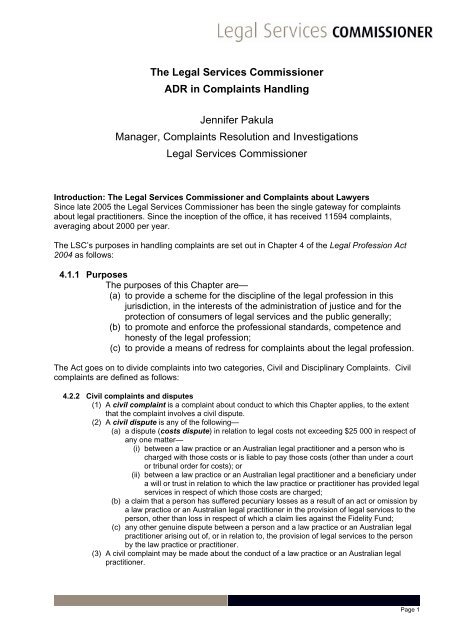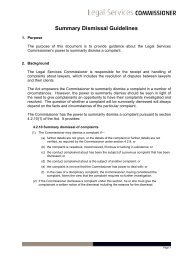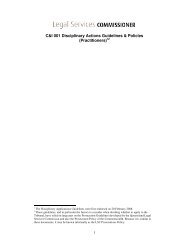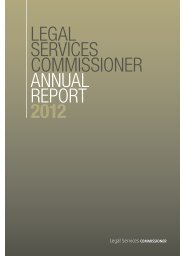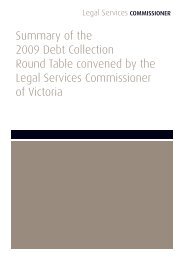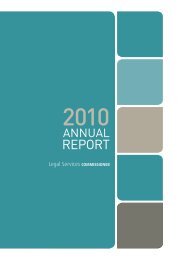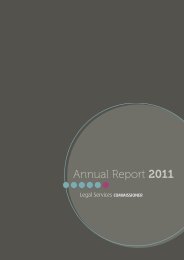The Legal Services Commissioner ADR in Complaints Handling ...
The Legal Services Commissioner ADR in Complaints Handling ...
The Legal Services Commissioner ADR in Complaints Handling ...
Create successful ePaper yourself
Turn your PDF publications into a flip-book with our unique Google optimized e-Paper software.
<strong>The</strong> <strong>Legal</strong> <strong>Services</strong> <strong>Commissioner</strong><strong>ADR</strong> <strong>in</strong> Compla<strong>in</strong>ts Handl<strong>in</strong>gJennifer PakulaManager, Compla<strong>in</strong>ts Resolution and Investigations<strong>Legal</strong> <strong>Services</strong> <strong>Commissioner</strong>Introduction: <strong>The</strong> <strong>Legal</strong> <strong>Services</strong> <strong>Commissioner</strong> and Compla<strong>in</strong>ts about LawyersS<strong>in</strong>ce late 2005 the <strong>Legal</strong> <strong>Services</strong> <strong>Commissioner</strong> has been the s<strong>in</strong>gle gateway for compla<strong>in</strong>tsabout legal practitioners. S<strong>in</strong>ce the <strong>in</strong>ception of the office, it has received 11594 compla<strong>in</strong>ts,averag<strong>in</strong>g about 2000 per year.<strong>The</strong> LSC’s purposes <strong>in</strong> handl<strong>in</strong>g compla<strong>in</strong>ts are set out <strong>in</strong> Chapter 4 of the <strong>Legal</strong> Profession Act2004 as follows:4.1.1 Purposes<strong>The</strong> purposes of this Chapter are—(a) to provide a scheme for the discipl<strong>in</strong>e of the legal profession <strong>in</strong> thisjurisdiction, <strong>in</strong> the <strong>in</strong>terests of the adm<strong>in</strong>istration of justice and for theprotection of consumers of legal services and the public generally;(b) to promote and enforce the professional standards, competence andhonesty of the legal profession;(c) to provide a means of redress for compla<strong>in</strong>ts about the legal profession.<strong>The</strong> Act goes on to divide compla<strong>in</strong>ts <strong>in</strong>to two categories, Civil and Discipl<strong>in</strong>ary Compla<strong>in</strong>ts. Civilcompla<strong>in</strong>ts are def<strong>in</strong>ed as follows:4.2.2 Civil compla<strong>in</strong>ts and disputes(1) A civil compla<strong>in</strong>t is a compla<strong>in</strong>t about conduct to which this Chapter applies, to the extentthat the compla<strong>in</strong>t <strong>in</strong>volves a civil dispute.(2) A civil dispute is any of the follow<strong>in</strong>g—(a) a dispute (costs dispute) <strong>in</strong> relation to legal costs not exceed<strong>in</strong>g $25 000 <strong>in</strong> respect ofany one matter—(i) between a law practice or an Australian legal practitioner and a person who ischarged with those costs or is liable to pay those costs (other than under a courtor tribunal order for costs); or(ii) between a law practice or an Australian legal practitioner and a beneficiary undera will or trust <strong>in</strong> relation to which the law practice or practitioner has provided legalservices <strong>in</strong> respect of which those costs are charged;(b) a claim that a person has suffered pecuniary losses as a result of an act or omission bya law practice or an Australian legal practitioner <strong>in</strong> the provision of legal services to theperson, other than loss <strong>in</strong> respect of which a claim lies aga<strong>in</strong>st the Fidelity Fund;(c) any other genu<strong>in</strong>e dispute between a person and a law practice or an Australian legalpractitioner aris<strong>in</strong>g out of, or <strong>in</strong> relation to, the provision of legal services to the personby the law practice or practitioner.(3) A civil compla<strong>in</strong>t may be made about the conduct of a law practice or an Australian legalpractitioner.Page 1
From this, you can see that a civil dispute is generally one between a solicitor and client – theexception to the rule be<strong>in</strong>g beneficiaries to estates or trusts, who can also dispute costs. However,what about the many disputes that may <strong>in</strong>volve a lawyer and fall outside these def<strong>in</strong>itions?Consider these examples:• A city agent or expert witness chas<strong>in</strong>g payment of costs from the practitioner who reta<strong>in</strong>edthem;• A lessee or mortgagor disput<strong>in</strong>g the lessor’s or mortgagee’s legal costs;• A dispute about costs where the total amount of legal fees exceeds $25,000;• A dispute between former partners <strong>in</strong> a firm about ongo<strong>in</strong>g display of the sign for the formerfirm.<strong>The</strong> other category is the Discipl<strong>in</strong>ary Compla<strong>in</strong>t, def<strong>in</strong>ed as follows:4.2.3 Discipl<strong>in</strong>ary compla<strong>in</strong>ts(1) A discipl<strong>in</strong>ary compla<strong>in</strong>t is a compla<strong>in</strong>t about conduct to which this Chapterapplies to the extent that the conduct, if established, would amount tounsatisfactory professional conduct or professional misconduct.From this, it is evident that a discipl<strong>in</strong>ary compla<strong>in</strong>t needs to cross a threshold before it will be<strong>in</strong>vestigated: the conduct alleged would have to be someth<strong>in</strong>g that, if proved, could amount tounsatisfactory professional conduct or professional misconduct. <strong>The</strong>se are quite high standards.“Unsatisfactory professional conduct” is def<strong>in</strong>ed <strong>in</strong> s.4.4.2 of the Act as follows:unsatisfactory professional conduct <strong>in</strong>cludes conduct of an Australian legalpractitioner occurr<strong>in</strong>g <strong>in</strong> connection with the practice of law that falls short of thestandard of competence and diligence that a member of the public is entitled toexpect of a reasonably competent Australian legal practitioner.This standard is beyond a mere mistake or oversight, and it is important to avoid the subjectivity<strong>in</strong>to which this standard could so easily fall: it is the standard of a reasonably competentpractitioner. While many compla<strong>in</strong>ants allege negligence, not all allegations will lead to an<strong>in</strong>vestigation, because not all negligence is a conduct issue. Particularly, it is not appropriate forthe LSC to be provid<strong>in</strong>g a second op<strong>in</strong>ion on what advice should have been given at the time,particularly given that we were not there at the time, we don’t have all those facts at hand, and thatmany legal matters are <strong>in</strong>herently ’grey’, mean<strong>in</strong>g that there will be a range of possible advice thatmay be given rather than one def<strong>in</strong>itive answer. This would not, of course, be the case with ademonstrable error that had a significant impact on the compla<strong>in</strong>ts. For example, a solicitoradvised an executor client that the will was <strong>in</strong>valid rather than subject to challenge where thewitnesses sign with two different pens. He advised her to adm<strong>in</strong>ister the estate <strong>in</strong> accordance withthe rules of <strong>in</strong>testacy rather than <strong>in</strong> accordance with testator’s wishes, which resulted <strong>in</strong> familyconflict, delay and a major costs blow-out to a very modest estate.Examples of unsatisfactory professional conduct would <strong>in</strong>clude:• Some <strong>in</strong>stances of conflict of <strong>in</strong>terest that do not have serious consequences for the parties<strong>in</strong>volved;• Mislead<strong>in</strong>g correspondence to an oppos<strong>in</strong>g practitioner;• Failure to advise about the expiry of a limitation period;• Significant and obvious negligence.“Professional misconduct” is def<strong>in</strong>ed as follows:For the purposes of this Act—professional misconduct <strong>in</strong>cludes—Page 2
(a)unsatisfactory professional conduct of an Australian legal practitioner,where the conduct <strong>in</strong>volves a substantial or consistent failure to reach orma<strong>in</strong>ta<strong>in</strong> a reasonable standard of competence and diligence; and(b)conduct of an Australian legal practitioner, whether occurr<strong>in</strong>g <strong>in</strong>connection with the practice of law or occurr<strong>in</strong>g otherwise than <strong>in</strong>connection with the practice of law, that would, if established, justify af<strong>in</strong>d<strong>in</strong>g that the practitioner is not a fit and proper person to engage <strong>in</strong> legalpractice.Note that it is an <strong>in</strong>clusive def<strong>in</strong>ition. <strong>The</strong> common law standards of misconduct cont<strong>in</strong>ue to apply,particularly that the conduct would be of the k<strong>in</strong>d viewed by peers as ‘disgraceful anddishonourable’. Only a few very serious cases could fall <strong>in</strong>to this category. Recent examples<strong>in</strong>clude:• Tak<strong>in</strong>g executor’s commission without obta<strong>in</strong><strong>in</strong>g appropriate consent of beneficiaries;• Failure to pay moneys earmarked for barristers’ fees;• Trust defalcations;• Dishonest and fraudulent activity.Once a compla<strong>in</strong>t is categorised as ‘discipl<strong>in</strong>ary’, the aim is to <strong>in</strong>vestigate and to establish whetherthere is sufficient evidence to make it reasonably likely that the Victorian Civil and Adm<strong>in</strong>istrativeTribunal ("VCAT") would f<strong>in</strong>d the practitioner guilty of unsatisfactory professional conduct orprofessional misconduct.Needless to say, there are many compla<strong>in</strong>ts made that are about a practitioner’s behaviour thatcould not amount to unsatisfactory professional conduct or professional misconduct. Take forexample the follow<strong>in</strong>g:• a practitioner be<strong>in</strong>g abrupt or <strong>in</strong>sensitive;• a practitioner urg<strong>in</strong>g a client – often for good reasons - to accept a settlement that theydon’t like;• a practitioner giv<strong>in</strong>g advice that seems to the client unclear or not really to the po<strong>in</strong>t;• Delay and communication issues that are annoy<strong>in</strong>g but <strong>in</strong>sufficient to amount to adiscipl<strong>in</strong>ary breach.As such, there is a third, large category of compla<strong>in</strong>t: the NOTAs (none of the above) which are notdescribed by the Act <strong>in</strong> any significant way. <strong>The</strong> big question the <strong>Commissioner</strong> must deal with is,how do we handle compla<strong>in</strong>ts that do not strictly fit the categories set out <strong>in</strong> the Act?One option is to summarily dismiss them, but that would result <strong>in</strong> well over half our compla<strong>in</strong>tsbe<strong>in</strong>g dismissed without further action. This would be a failure <strong>in</strong> relation to the third aim of the<strong>Commissioner</strong> as set out <strong>in</strong> s.4.1.1 of the Act – which is to provide a means of redress forcompla<strong>in</strong>ts about the legal profession.Another option is to take a very generous view of what might constitute a discipl<strong>in</strong>ary compla<strong>in</strong>tand subject it to a full-blown <strong>in</strong>vestigation – but <strong>in</strong> the past that resulted <strong>in</strong> delays lead<strong>in</strong>g to an<strong>in</strong>evitable dismissal of the compla<strong>in</strong>t, a situation with which neither compla<strong>in</strong>ant nor practitionerwere happy.A third option is to simply deal with such compla<strong>in</strong>ts <strong>in</strong> a way that will br<strong>in</strong>g about the mostsatisfactory solution for the parties. This approach <strong>in</strong>evitably <strong>in</strong>volves the use of <strong>ADR</strong> techniques,and very much br<strong>in</strong>gs to bear an <strong>ADR</strong> m<strong>in</strong>dset. Where the issue is service related, an<strong>in</strong>vestigation will not resolve the matter <strong>in</strong> anyone’s m<strong>in</strong>d. A compla<strong>in</strong>ant generally does not carewhether the Tribunal would be likely to f<strong>in</strong>d a practitioner guilty of a discipl<strong>in</strong>ary breach. <strong>The</strong>y do,Page 3
however, want to have their say, be understood and recognised, and <strong>in</strong> certa<strong>in</strong> circumstances,receive some k<strong>in</strong>d of redress, such as a payment – <strong>in</strong> many cases token – or an acknowledgementor apology from the practitioner. This has been the strategy beh<strong>in</strong>d the formation of our RapidResolution Team (RRT) some fifteen months ago.<strong>The</strong> RRT is closely related to our exist<strong>in</strong>g Disputes Resolution Team (DRT) <strong>in</strong> that both arefocussed on resolution rather than <strong>in</strong>vestigation. Whilst the DRT tends to concentrate on mattersclearly fall<strong>in</strong>g with<strong>in</strong> the parameters of a civil dispute under the Act, the aim of the RRT has been todeal creatively and effectively with those ‘NOTA’ compla<strong>in</strong>ts. <strong>The</strong> RRT aims to take generaldisputes, service-related compla<strong>in</strong>ts and matters that clearly <strong>in</strong>dicate summary dismissal, and todeal with them as quickly and efficiently as possible – mean<strong>in</strong>g that even <strong>in</strong> a matter where there isnoth<strong>in</strong>g that can be done by way of orders, discipl<strong>in</strong>ary f<strong>in</strong>d<strong>in</strong>gs or referral to VCAT, some effort ismade to resolve any present<strong>in</strong>g issue capable of resolution, or to give a personal explanation ofwhy the compla<strong>in</strong>t cannot be <strong>in</strong>vestigated. <strong>The</strong> work of the RRT and its use of <strong>ADR</strong> techniqueswill be described <strong>in</strong> more detail later <strong>in</strong> this paper.Use of <strong>ADR</strong> <strong>in</strong> compla<strong>in</strong>ts – <strong>Legal</strong> Profession Act civil disputesAs set out above, the Act provides for the resolution of certa<strong>in</strong> categories of civil dispute betweensolicitors and clients. <strong>The</strong>se provisions mirror the pioneer<strong>in</strong>g provisions set out <strong>in</strong> the <strong>Legal</strong>Practice Act 1996. As such, the LSC and its predecessors have for some time been engaged <strong>in</strong>assist<strong>in</strong>g parties to resolve disputes, particularly over costs.It is a unique feature of the Victorian legislation that the costs dispute process can only go ahead ifthe compla<strong>in</strong>ant lodges with the LSC any outstand<strong>in</strong>g costs (with provision for dispensation iflodgement would cause undue hardship). While this concept had been <strong>in</strong>cluded, withmodifications, <strong>in</strong> the draft national profession law (s.5.3.11), unfortunately it seems now to havebeen dropped. <strong>The</strong> way it works is that money is lodged <strong>in</strong> an <strong>in</strong>terest-bear<strong>in</strong>g account. If thedispute does not settle, the parties have the option of apply<strong>in</strong>g to VCAT for resolution and divisionof the moneys – if neither does this, the money is paid to the practitioner. If the compla<strong>in</strong>antwithdraws the compla<strong>in</strong>t, the money is paid to the practitioner; if it settles, the money is dividedaccord<strong>in</strong>g to the settlement agreement.<strong>The</strong> beauty of this provision is that it provides a great <strong>in</strong>centive for parties to negotiate and settle.For the practitioner, the money is there and available without the need to sue the former client – itis <strong>in</strong> their <strong>in</strong>terests to compromise for the sake of the ‘bird <strong>in</strong> the hand’. For the client, acompromise is also attractive, as the alternatives <strong>in</strong>volve either the risk and stress of go<strong>in</strong>g toVCAT or the whole amount be<strong>in</strong>g paid to the practitioner.It is also important that, once the costs dispute has been lodged with the LSC, the practitioner maynot sue the compla<strong>in</strong>ant for the costs (s.4.3.2), thus br<strong>in</strong>g<strong>in</strong>g them to the negotiat<strong>in</strong>g table withsome force!It is <strong>in</strong>terest<strong>in</strong>g that when compla<strong>in</strong>ants approach the LSC with a costs dispute, it is usually with arights-based m<strong>in</strong>dset. As such, we are asked to reduce or cancel a bill, or order that particularitems be removed. <strong>The</strong> compla<strong>in</strong>ants’ perception is that the LSC is like a Court, and that we canorder the practitioner to amend his or her bill. Similarly, practitioners often come to the processsuggest<strong>in</strong>g that the bill be assessed to establish whether the work done on the file justifies the bill –aga<strong>in</strong>, an ‘objective’ rights-based approach where an umpire is called upon to make a b<strong>in</strong>d<strong>in</strong>gdecision about the dispute.However, the reality is that most compla<strong>in</strong>ants are not really concerned with whether a costsassessor would agree with the bill – their issues are generally service related. It is not uncommonto receive a compla<strong>in</strong>t that goes <strong>in</strong>to great detail about the poor service and confus<strong>in</strong>g advicePage 4
given, failures to return phone calls <strong>in</strong> a timely manner or at all, the practitioner’s <strong>in</strong>sensitivity andpoor social skills etc – to summarise, “<strong>The</strong>y did a bad job, I’m not happy and I’m not pay<strong>in</strong>g for it.”It is very important at this stage to establish that the role of umpire is not our role. Our aim is toprovide a fair process that will enable the parties to resolve the dispute themselves. If, aftermak<strong>in</strong>g fair attempts to resolve the dispute, we form the op<strong>in</strong>ion that this cannot be done, theparties are given a letter sett<strong>in</strong>g out this decision and giv<strong>in</strong>g them the right to approach VCAT tomake an application for resolution of the dispute with<strong>in</strong> the next 60 days.<strong>The</strong> Act gives the LSC broad power to resolve disputes:4.3.5 <strong>Commissioner</strong> to attempt to resolve civil dispute(1) <strong>The</strong> <strong>Commissioner</strong> must attempt to resolve a civil dispute that is the subject of a civilcompla<strong>in</strong>t and may take any action he or she considers necessary to assist the parties toreach agreement.(2) Without limit<strong>in</strong>g subsection (1), the <strong>Commissioner</strong> may—(a) refer a civil dispute for mediation under Division 3; or(b) <strong>in</strong> the case of a costs dispute—arrange for a non-b<strong>in</strong>d<strong>in</strong>g assessment of legal costs.(3) For the purposes of an assessment referred to <strong>in</strong> subsection (2)(b), the <strong>Commissioner</strong> mayrequire the law practice or Australian legal practitioner concerned to provide any relevantdocuments or <strong>in</strong>formation.(4) Evidence of anyth<strong>in</strong>g said or done <strong>in</strong> the course of attempt<strong>in</strong>g to resolve a civil dispute is notadmissible <strong>in</strong> proceed<strong>in</strong>gs before the Tribunal or any other proceed<strong>in</strong>gs relat<strong>in</strong>g to thesubject-matter of the dispute.(5) This section does not apply if—(a) the <strong>Commissioner</strong> has dismissed the compla<strong>in</strong>t <strong>in</strong> respect of the dispute under section4.2.10 or 4.3.3(3); or(b) the <strong>Commissioner</strong> considers that a civil dispute is unlikely to be resolved, or is notsuitable for resolution by the <strong>Commissioner</strong>.Our usual approach is one of telephone shuttle mediation. <strong>The</strong> compla<strong>in</strong>t is summarised <strong>in</strong> writ<strong>in</strong>gto both parties – the compla<strong>in</strong>ant be<strong>in</strong>g asked to confirm if we have or have not understood theirissues – and the process is expla<strong>in</strong>ed. From there, our dispute resolution team members call bothparties to get the negotiation under way.<strong>The</strong> first telephone call is generally quite a long one, reflect<strong>in</strong>g the issue exploration that needs tobe undertaken. In many cases, it is important to talk through the present<strong>in</strong>g service issues, oftenas compla<strong>in</strong>ants will come to us demand<strong>in</strong>g that discipl<strong>in</strong>ary action be taken. However, thedecision to undertake a discipl<strong>in</strong>ary compla<strong>in</strong>t <strong>in</strong>vestigation is the <strong>Commissioner</strong>’s to make, not aright of the compla<strong>in</strong>ant. Nonetheless, it is vital to understand the compla<strong>in</strong>ant’s issues and to talkthem through. Also, it is important that we understand accurately what the compla<strong>in</strong>ant hopes toachieve by mak<strong>in</strong>g the compla<strong>in</strong>t. If the compla<strong>in</strong>ant wants someth<strong>in</strong>g we can’t provide, forexample to reopen their case, it is important that they are given a more realistic understand<strong>in</strong>g ofwhat the compla<strong>in</strong>t process can achieve as soon as possible. This call is also important <strong>in</strong>establish<strong>in</strong>g rapport with the compla<strong>in</strong>ant and understand<strong>in</strong>g of the LSC’s role as a neutral thirdparty seek<strong>in</strong>g to resolve their matter.By far the largest category of law from which compla<strong>in</strong>ts arise is Family Law. This area of lawprovides a consistent 20 – 25% of compla<strong>in</strong>ts each year, and compla<strong>in</strong>ants are generally suffer<strong>in</strong>gfrom the impact of the divorce and related matters. When they are unhappy with the legal processand with the result, there is a strong desire to obta<strong>in</strong> some k<strong>in</strong>d of redress. As the LSC is a body towhich people can br<strong>in</strong>g their compla<strong>in</strong>ts, it is not uncommon to transfer much of the angst aris<strong>in</strong>gout of the personal circumstances – about which noth<strong>in</strong>g can be done – to a practitioner whom theLSC can punish. It is therefore extremely important to unpack these issues and enablecompla<strong>in</strong>ants to understand what the practitioner’s role has been <strong>in</strong> the entire process.Page 5
Some compla<strong>in</strong>ants present with a very hardened, extreme position – typically that they should paynoth<strong>in</strong>g at all, and that the practitioner should be struck off. In these circumstances, a conflictcoach<strong>in</strong>g approach has at times been adopted with some success.When speak<strong>in</strong>g to the practitioner <strong>in</strong> the first <strong>in</strong>stance, there is often a fair bit of heat to endure onthe part of the compla<strong>in</strong>t handler. It is not uncommon for a practitioner to state that the compla<strong>in</strong>tis utterly unjustified, that they ‘busted their chops’ for this ungrateful person, they are entitled toevery cent and they will not negotiate. However, listen<strong>in</strong>g, explor<strong>in</strong>g and time will often take theheat out of the practitioner’s response. <strong>The</strong> DRT members work hard at establish<strong>in</strong>g rapport withpractitioners and help<strong>in</strong>g them to see that our function is not to punish, but to help. Practitionersquickly see the merit <strong>in</strong> avoid<strong>in</strong>g the cost and stress of VCAT and understand that our aim is not toadvocate for the compla<strong>in</strong>ant, but to provide a neutral and mutually beneficial process.<strong>The</strong> next stage is to discuss with the parties the types of options that are open to them, bear<strong>in</strong>g <strong>in</strong>m<strong>in</strong>d what the LSC can and cannot do with their compla<strong>in</strong>t. <strong>The</strong>re are many different approachesto obta<strong>in</strong><strong>in</strong>g <strong>in</strong>formation and explanations – for example the compla<strong>in</strong>t handler read<strong>in</strong>g the file orrequest<strong>in</strong>g specific responses from the practitioner to be given to the compla<strong>in</strong>ant – not a formalwritten explanation <strong>in</strong> response to a discipl<strong>in</strong>ary <strong>in</strong>vestigation, but an explanation with a view tohelp<strong>in</strong>g the compla<strong>in</strong>ant understand the circumstances and resolve the dispute. Sometimes apractitioner will send <strong>in</strong> a quite <strong>in</strong>flammatory letter. We don’t pass these on as a general rule;however we will either summarise the essence of the explanation <strong>in</strong> a letter we write to thecompla<strong>in</strong>ant, or we will ask the practitioner to do a judicious edit, bear<strong>in</strong>g <strong>in</strong> m<strong>in</strong>d the purpose ofthe letter.An <strong>in</strong>formal, non-b<strong>in</strong>d<strong>in</strong>g costs assessment can be obta<strong>in</strong>ed by the LSC, although this is generallysometh<strong>in</strong>g we do only if both parties want an <strong>in</strong>dependent third party to make that judgment call.Even then, the parties are not bound by the assessment, but it often provides a good start<strong>in</strong>g po<strong>in</strong>tfor more focussed negotiation.A lot of reality test<strong>in</strong>g goes on, <strong>in</strong>clud<strong>in</strong>g discuss<strong>in</strong>g with the parties their best and worstalternatives to a negotiated outcome. Here, it is important to discuss what happens should thematter proceed to VCAT, especially from the compla<strong>in</strong>ant’s po<strong>in</strong>t of view. Compla<strong>in</strong>ants need tounderstand that if they proceed to VCAT and the member does not significantly reduce the bill,they run the risk of hav<strong>in</strong>g a costs order made aga<strong>in</strong>st them – see for example Lark<strong>in</strong>g v McDonaldMurholme (<strong>Legal</strong> Practice) [2010] VCAT 1122 (17 June 2010); conversely, practitioners can beordered to pay the applicant compla<strong>in</strong>ants’ costs – see for example Leong v J P Sesto & Co & Ors(<strong>Legal</strong> Practice) [2010] VCAT 367 (29 March 2010).If no VCAT application is made by the compla<strong>in</strong>ant after the LSC decides that the matter cannot besettled by this office, the practitioner will simply need to wait another 60 days before the whole sumof money is paid to them, and the compla<strong>in</strong>ant pays the entire amount orig<strong>in</strong>ally demanded. Thispossible outcome is an important factor that encourages compromise by the parties.If settlement is reached, the f<strong>in</strong>al stage is for the LSC to prepare a settlement agreement reflect<strong>in</strong>gthe terms of agreement. While it is usually the case that the ma<strong>in</strong> term of the agreement is thedivision of moneys held on trust, other terms can be <strong>in</strong>cluded, such as hand<strong>in</strong>g over client files,apologies and so on. <strong>The</strong> agreement can be certified and registered with the Magistrates Courtshould either party wish to enforce it.In the end, the majority of disputes do settle with<strong>in</strong> our office. Very few disputes are referred toformal mediation as it is generally only appropriate where the issues are complex and the money atstake is quite significant.Page 6


